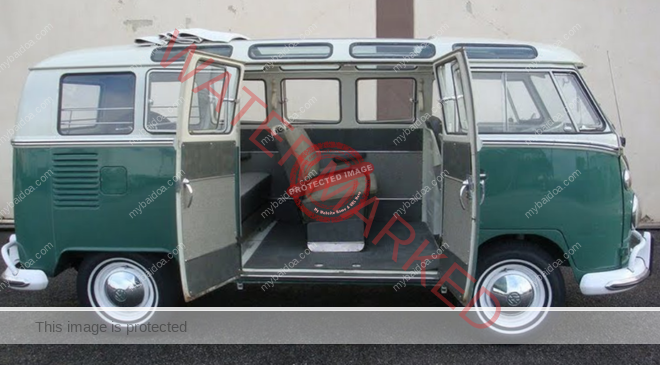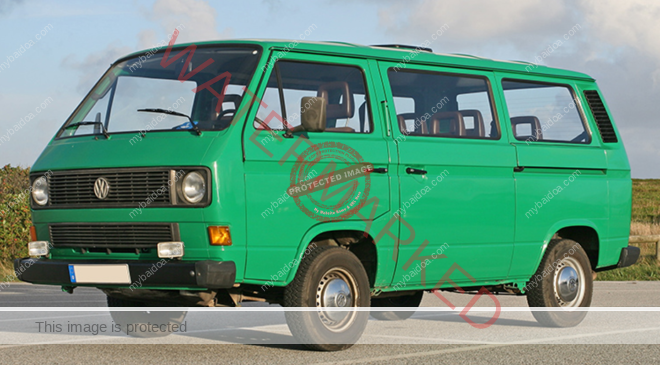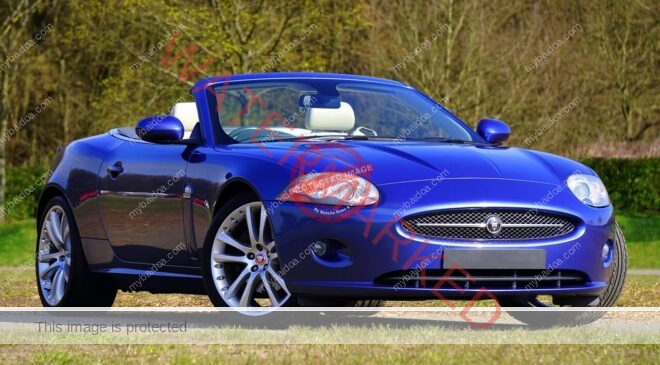T1 Transporters were built in Wolfsburg from 1950 to 1956, after which time production was moved to Volkswagen’s new factory in Hanover due to its popularity and the mass orders. The vehicle came with a split windshield and included multiple variations throughout the years. This includes changes to the Volkswagen air-cooled engine, the wheels used, rear barn doors, cargo capacity and the engine bay size. Sliding doors were added as an option from 1964.
There were various model options for the Transporter including; the Panel Van, Microbus (7-seater and 9-seater versions), Samba, Kombi, Ambulance, Pick-Up and Double Cab.
Volkswagen stopped production of the T1 in 1967 in Germany, although production continued in Brazil until 1975.

Volkswagen Type 2 Bay Window (T2)
1967 – 1979

Following the success of the T1, Volkswagen introduced the T2 Transporter (more commonly known as the ‘Bay Window’ or ‘Bay’) to the public in 1967. The T2 saw the disappearance of the T1’s split windshield and the vehicle was also noticeably larger and heavier than the previous Transporter.
Some of the upgrades included a larger engine, 12 volts battery/electrical system and half-shaft axle rear suspension. Other modifications included the 90° front doors, front brake discs, new wheels with brake ventilation, placing of the front indicators and the addition of side bars which could be used as a step for getting in and out of the van.
The Volkswagen T2 was built in Germany until 1979, with Mexico carrying on the production up until 1994.

Volkswagen T3 / T25
1979 – 1992

Volkswagen started production of their T3 (or T25 as it’s often known) Transporter in 1979 and moved on to market the Transporter under various names worldwide. In Europe it was known as the Transporter/Caravelle, South Africa knew it as the Microbus, whilst North and South American knew of it as the Vanagon.
Once again the vehicle grew larger in size and heavier in weight in comparison to the prior Type 2 Transporters. The vehicle itself was visibly squarer than previous versions.
During the production of the T3, the Westfalia Camper was marketed by Volkswagen as a conversion option that included a sink, oven, refrigerator and pop-up roof.
There were many features available with the T3 including; air conditioning, power steering, heated mirrors, and much more. The T3 Transporter had larger disc brakes in the front and larger drums in the rear than earlier Type 2’s. There was also an oil filler tube for the engine located behind the license plate.
Production in Germany drew to a halt in 1990, but continued until 1992 in Graz/Austria and until 2002 in South Africa

Volkswagen T4
1990 – 2003

With the success of previous Transporters, Volkswagen began production of the T4 in 1990. The van had a water-cooled engine in the front of the vehicle, making it the first Volkswagen Transporter to feature this.
Volkswagen marketed the T4 as the Eurovan in North America where the Transporter was very popular.
This fourth generation Transporter came with a range of options including:
- Standard or high-top roof
- Sliding door on passenger side or both
- Short of Long nose at the front of the vehicle (the longer nose allowing the installation of a V6 engine)
- Permanent 4WD system.
The Production of the T4 lasted until 2003 after a successful 13 years on the market, largely due to it being established as a very popular base vehicle for building campervans.

Volkswagen T5
2003 – 2016

Although the T5 was launched in 2002, production for the van didn’t begin until 2003. The van was available globally, excluding the United States due to the 25% extra chicken tax on importation costs.
The van was available in a wide range of variants including Short-Wheelbase (SWB) and Long-Wheelbase (LWB) vehicles with optional low, medium and high rooflines.
T5 Transporters were available in various configurations such as the Van, Minibus, Single-cab, Double-cab, Drop side or Chassis Truck. It was also available as a people carrier with various seating options, which were also known as the Shuttle, Kombi, Caravelle, and Multivan.
Kombi vans were the entry level for the people carrier Transporter range and were available with every roof height and wheelbase option. The van was able to seat up to eleven people.
Shuttle vans were the next level up and were only available as an SWB or LWB wheelbase option. Optional extras such as colour-coded bumpers and bench seats were offered with the Shuttle van.
The Caravelle came with most of the Kombi and Shuttle features as standard. The Caravelle van contains ten seats maximum and is only available in a Short Wheelbase or Long Wheelbase.
Multivans were available with six/seven seats and had a rail feature that allowed the seats to slide forward and backwards. The van included various conversion options that could fit into the rails and be moveable.
T5 GP / T5.1 / T5 Facelift
Volkswagen released a new version of the T5 Transporter which is often referred to as the T5 Facelift, due to the cosmetic changes made to the front of the vehicle. It included small changes such as traction control and day light running lights (DLRs), but the most significant change was the addition of an upgraded 180bhp engine.
The easiest way to spot the difference between the T5 and T5 GP is to look at the front edge of the bonnet above the VW badge. The T5 has a small cutout whereas the T5 GP does not.

Volkswagen T6
2015 – Present

In 2015, Volkswagen announced the sixth generation of their Transporter which had been modernised to feel more car-like than ever. The passenger side sliding door comes as standard and there is an option for a driver’s side sliding door also.
Compared to the changes in the T5 GP there have been numerous cosmetic changes to the van which includes; a new front bumper and grill design, changes to the light clusters and position of the side repeaters, a larger rear window, slightly modified rear bumper and a scallop around the number plate mounting area.
Some other new features include a 15% more economical fuel consumption, a 7-speed dual-clutch automatic gearbox option for higher-output models and a driving alert system which can detect whether the driver is tired.

The Future VW T7 Transporter

What we can expect from the future VW T7 Transporter is unclear at this time. Volkswagen often release prototype designs that hint at a futuristic design, but these are often dumbed-down when it comes to the actual model release.
What we can be sure of though is that the VW community will continue to thrive and that we will continue to see VW Transporters, from classic T1’s to modern T6’s, being used as campervans around the world.






















